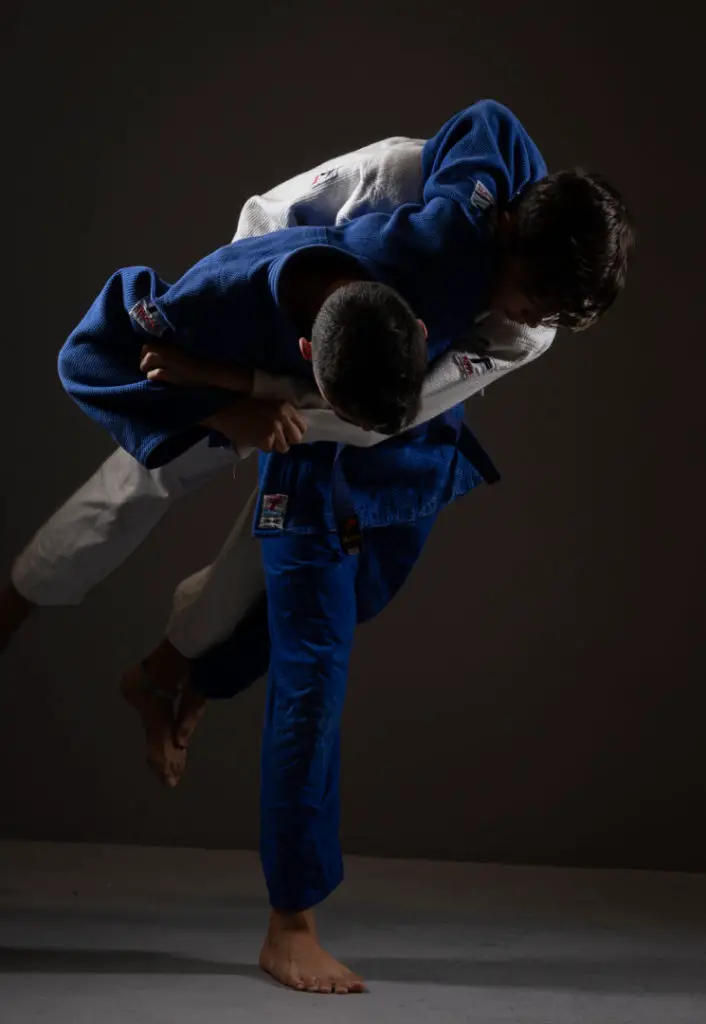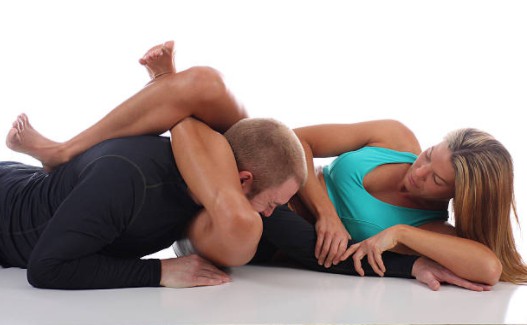Judo and Brazilian Jiu-Jitsu are both derived from Japanese Jiu-Jitsu. Judo concentrated on the takedown aspects whereas BJJ concentrated on the groundwork.
Judo will offer takedown and falling techniques to BJJ practitioners. Cross-training Judo and BJJ will create a more complete fighter since you have a base in both ground fighting and throws. Judo will improve some aspects of you BJJ; however, it is not necessary to become a deadly BJJ practitioner as some throws and grips are not useful in BJJ.
This article explains how Judo concepts and strategies can be beneficial for Brazilian Jiu-Jitsu (BJJ) practitioners.
What Does Judo Offer BJJ Practitioners?
Judo offers falling techniques, takedowns, top groundwork, conditioning, and aggression. Judo’s game plan centers around using leverages and opponents’ momentum to take them to the ground. Once on the ground, the opponent is controlled by pinning them for time or submitting them.

Rolling and Falling Strategies
Judo’s primary focus is the standup where takedowns are going to happen so learning how to fall properly is important for longevity and safety. Learning to roll or distribute impact when landing on the ground is key to reducing the risk of injury.
Landing on your head is a fast way to get knocked out!
Being aware of how to appropriately land when you get tossed is a principal skill that must be incorporated in grappling. These sorts of strategies are usually included in daily Judo warm-up routine.
Brazilian Jiu-Jitsu typically does not sufficiently teach or practice the stand-up game, especially at the white-belt level, so they don’t acquire sufficient experience falling in a real-life sparring situation.
- Sideways Break-fall: Learn how to fall on the sides and hit the floor with the same side arm when you are landing to lessen the toss’ effect on your body. Tucking in your chin reduces the risk of your head from bouncing on the ground.
- Backward Break-fall: Just imagine a scenario where you are thrown in the air straightforwardly onto your backside, hit the floor with both your arms out at a 45-degrees angle from your body.
I’ve included a well-explained video about how to break-fall. Everyone should have some knowledge about how to break-fall when practicing Jiu-Jitsu and should incorporate it in your warm-up.
Takedowns
Judo takedowns, unlike wrestling takedowns, use a Gi as the primary method to throw someone to the ground. Most Judo throws are performed in a continuous motion. It focuses on using your opponent’s momentum to take them to the ground.
Judo tossing strategies are an incredible supplement to Gi-intended Brazilian Jiu-Jitsu (BJJ) practitioners and will make their standup game strong.
Regardless of its notoriety and accentuation on utilizing the Gi, Judo offers alternative moves and grips that allow for training without it too.
The below content centers around how Judo could strengthen your takedown abilities:
- Focus on Takedowns: Judo schools commonly emphasize strengthening takedowns than groundwork in their educational plan. It’s the opposite way around for Brazilian jiu-jitsu. Thus, Judo training will make you deadly on the ground and standing.
- Attacking Mindset: The mindset in Judo is to take charge and start the takedown. This will naturally force Brazilian Jiu-Jitsu practitioners to self-defense and come out of their comfort zone.
- Entry: Brazilian Jiu-jitsu practitioners ailing in standup experience will generally be reckless and sloppy in their endeavor to clinch with their adversary. Judo training provides you with mastery in grip advantage, penetrating securing range with footwork, and proper body timing and position.
Groundwork
Although Brazilian Jiu-Jitsu specializes in grappling on the ground (Newaza, in Japenese), Judo uses techniques and concepts that could be adjusted to Brazilian Jiu-Jitsu.
- Top Pressure: Judokas are infamous for their skills to create top pressure and have even submitted different grapplers with this ability.
- Change Your Angle: It’s normal for Judokas to pivot their torso to shift the body angle to shed their adversary’s collar holds and nullify the firm-arm attempts. This idea could be applied to a Brazilian Jiu-Jitsu professional who advanced their rival’s guard and endeavored to subside into side control.
- Control: Since pinning is a suitable alternative to win points and even triumph a Judo match, you could figure how to overwhelm control by embracing these pinning strategies that might appear to be unorthodox to other Brazilian Jiu-Jitsu practitioners.
Conditioning And Aggression
A different mindset is needed to be zealous in Judo. The variance of “going gentle” in a competing session contrasts among Brazilian Jiu-Jitsu practitioners and Judokas.
Judo training sessions often take place at a quicker pace and may appear to be more unpleasant as they are grappling and throwing each other to the ground. Due to this basic explanation, Judokas are mainly in good cardiovascular shape.
In BJJ it is possible to keep the pace slow (in the Gi) and slowly work towards a dominant position.
The below-mentioned Judo qualities could increase your chances of success in Brazilian Jiu-Jitsu matches:
- Quicker Pace: It helps to increase your speed for attempting submissions or getting into positions.
- Dynamic: The power in Judo matches simply permits for split-second responses, which advance rapid decision making.
Cross-Training Brazilian Jiu-Jitsu And Judo
Many people from the sports or fitness world believe that some degree of cross-training is advantageous for competitors. Whether you are a master or a weekend warrior, combining sports-explicit training and competition with another game can help you improve your lifestyle and performance in your primary discipline.
When talking about Judo and Brazilian Jiu-Jitsu, both disciplines’ training may appear to be entirely coherent on paper. The former’s roots are in the latter. They both are the art of grappling that includes positions, throws, and submissions.
Hence, the question arises: Is participating in these two disciplines simultaneously a compelling type of cross-training or a distraction from one another?
The appropriate answer is ‘Maybe.’
In case you are joining martial arts as a hobby, or fitness goal, or simply because you admire it the answer is entirely up to you. What kind of martial arts training is favorable for you? Which one are you captivated to the most? What makes you eager to hit the gym or fitness center daily?
This is something where you must and can follow what your heart says.
John Danaher has mentioned the deficiencies in the stand-up game in Jiu-Jitsu and made a point in saying that some techniques in Judo and Wrestling are transferrable and some are not. Techniques from both disciplines should be investigated and dissected to develop BJJ’s approach to the stand-up game.
Pros And Cons Of Cross-Training BJJ And Judo
| Pros | Cons |
| Learn more advanced throws in Judo that you can use in BJJ | Takes longer to get good at either sport. |
| Train techniques in BJJ that are not taught in Judo, such as wrestling takedowns, leg attacks, positional battles, etc.. | You may be training more to get equal time in both, leading to potential overtraining or burnout. |
| Judo will allow you to drill break-falls and takedowns. | Many Judo throws are ineffective in BJJ and could lead to your opponent taking your back. |
| Reversal techniques from the bottom positions will give you an advantage in Judo to prevent pins. | Many Judo throws don’t work well in No-Gi. |
| Judo will give you counters to throw techniques giving you an upper-hand in BJJ. | It may take you until Blue-belt to get good enough to use BJJ techniques in Judo and Brown-belt in Judo to use those techniques in BJJ. |
Judo Or Brazilian Jiu-Jitsu: Which Is Better For Self-Defense?
Brazilian Jiu-Jitsu fundamentals allow a smaller, weaker person to defend themselves against a bigger, stronger, heavier opponents by using leverage and weight distribution. Judo requires you to capitalize on adjusting to and evading your opponent’s attack to cause him to lose his balance, thus reducing his power, so you can throw them to the ground.
Jiu-Jitsu offers the ability to fight from the top, bottom, and even from the ground if your opponent is standing. These attributes are important when defending yourself, especially from an attack that may put you on the ground.
Judo is a great way to use your opponent’s momentum to throw them on the ground if they initiate an attack. Once they’re on the ground you have the option to pin them until help arrives or run.

Brazilian Jiu-Jitsu typically offers more live experience than Judo because it incorporates rolling (live sparring) which gives you real experience fighting as you and your opponent will be trying to control, dominate, and submit one another. BJJ starts on the feet like Judo; however, once the person hits the ground BJJ is just getting started.
I think Brazilian Jiu-Jitsu offers more variation and live experience that better readies someone to defend themselves. With just one year of training BJJ (two stripes on my white belt), I was able to control and dominate new white-belts that both outweighed me by 100-120lbs and have football/weight lifting backgrounds.
Furthermore, Jiu-Jitsu teaches you how to fight from your back and it works against larger, stronger opponents. For females, I think Jiu-Jitsu is a must-have skill for self-defense.
It is important to note that neither Judo nor BJJ incorporates punches in their game plan. When learning either Judo or BJJ for self-defense think about when your opponent could punch/kick you and where you are venerable to strikes. Taking an MMA class or two can give you a great idea if you need a real example.
Conclusion
Judo will assist your stand-up game in Brazilian Jiu-Jitsu and give you different options to take your opponent to the ground and pin them. Most Brazilian Jiu-Jitsu facilities do not teach sufficient takedowns, especially at the white-belt level, so having Judo to supplement those skills may be advantageous.
Judo will teach you falling techniques, takedowns, pinning, and aggression. Learning to fall properly is a valuable skill to learn to reduce the risk of injury and improve longevity. While having additional takedowns and grips to take your opponent to the ground can give you the upper hand.
Finally, Judo teaches students to be aggressive. It is hard to be passive or slow down matches when your opponent is trying to take you down, or you’re trying to take your opponent down. In BJJ it is possible to slow down the pace and wait for your opponent to tire out before you attack, Judo can teach you to be the aggressor.

